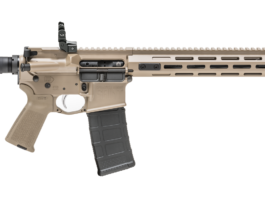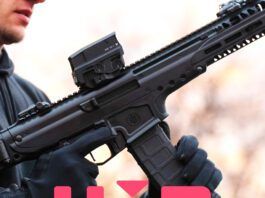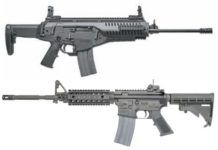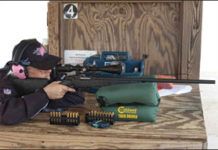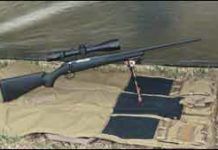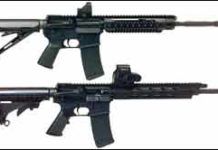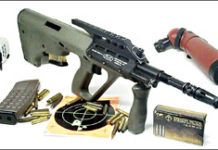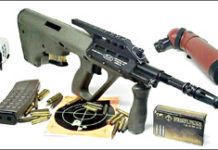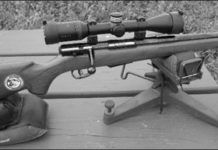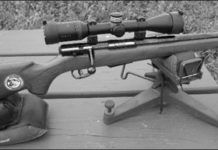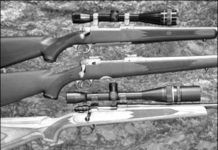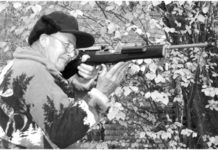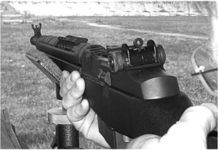Battle Rifles: Berettas New-Age ARX 100 vs. Colts LE6920 AR
If we were a rifle maker with a line of AR-15s, we might put up a neon sign outside our establishment that had an image of our carbine with a simple message below: "Millions and millions sold." Because while that might not quite be true for an individual maker's line, it is certainly true for the ArmaLite Rifle platform collectively. The various configurations of ARs are among the highest-selling rifle designs ever, and their appeal seems to keep broadening, even in the face of political restrictions in some jurisdictions.
Despite this popularity—or perhaps because of it—other designs suited for self defense want to take the AR down a notch, make a little cheddar for themselves at the expense of the standard defense rifle of our time. One such competitor du jour is the Beretta ARX 100, itself an adaptation of the successful ARX 160 military rifle made by the famous Italian gunmaker. The ARX 160 service rifle has shown up in several war zones, and it certainly is not an M16/M4/AR-15 rifle. In fact, the ARX platform has little in common with the AR, which could be a significant hurdle for commercial success, or perhaps the beginning of the next big thing. Which one is what we aimed to find out when we went shopping for a 5.56 NATO-chambered Beretta ARX 100 JXR11B00, $1522, a recent online price for the rifle at TombstoneTactical.com. We put it against a Colt M4 Carbine LE6920SOCOM, $1622, which we recently priced at a Houston-based firearms and floral-design store called Texas Guns and Roses (TexasGunsandRoses.com). This price also includes a $15 handling fee for online orders.
The disadvantage the Beretta had to overcome was that most experienced rifle shooters handle the AR-15 as if it were second nature. To help dial out some of that bias, we assembled a group of both novice and experienced raters for this project, one of whom has fired rifles, but never the AR-15 or the Beretta. With no prior AR-15 experience, we would see how quickly our novice could be brought up to speed on both rifles. Other shooters included a 20-year law-enforcement veteran, whose abstract on carbine training has been published on a federal level, and another rater who is a military captain recently returned from a fourteen-month deployment and a certified NRA instructor. We felt that this mix, along with other interested shooters, would help us pick the best battle rifle.
To test them, we used loads in different weights from several makers. We included Federal American Eagle 62-grain FMJ Green Tips (prior to the recent BATFE attempt at reclassifying them as armor piercing), Hornady 55-grain jacketed soft points, and Black Hills' 77-grain Open-Tip Match. We also fired the Black Hills 52-grain Match, Hornady 55-grain Zombie Max, and Federal's 55-grain JSP and Winchester's 55-grain FMJs. Here's what we found:
CZ-USAs 204 Ruger Bolt Action
243 Win. Bolt-Action Rifles Under $500: Ruger Vs Mossberg
Two E-Rifles Go Head to Head: Ruger Essential vs. Adcor Elite
AR-15 rifles continue to be churned out by more and more manufacturers. Frankly, the modular concept of the AR platform means that rifles can be built to specific price points, more easily, we think, than traditional bolt guns or other actions. And we recently found two such guns that illustrate how perfectly pitched the product price can be made to appeal to a specific customer.
The Ruger SR-556E "Essential" #5912 5.56mm NATO/223 Rem., $1375, is what Sturm, Ruger calls its value-priced two-stage piston-driven carbine. The major similarity between it and the SR-556FB (January 2010) is the carryover of Ruger's two-stage piston and multi-stage regulator. The major difference is, rather than a quad rail, the Essential has a round aluminum handguard with a full-length Picatinny rail only at 12 o'clock, so the rail and the flattop receiver align. The handguard is also drilled and tapped to accept sections of rail or handguard covers, available at www.ShopRuger.com, which allows the user to configure the handguard to his or her requirements while minimizing size and weight. It's also a significant cost savings over the quad rail.
Adcor Defense's B.E.A.R. Elite is the second generation of that company's modern automatic rifle line. Based in Baltimore, Adcor rolled out the original B.E.A.R. (Brown Enhanced Automatic Rifle, designed by and named for Michael J. Brown, executive vice president of operations at Adcor Defense) with a free-floating gas-piston system attached to the rail. This allowed for a free-floating barrel. Other features were a key-locked rail system, an ambidextrous forward-placed charging handle, and a polymer dust shield that protects the ejection port from debris.
The B.E.A.R. Elite tested here offers several enhancements to the original (hereafter, we'll spell it "Bear" so those capital letters don't scream on the page). The Bear Elite features an FN Manufacturing 1:7 twist hammer-forged, hard chrome-lined barrel with M249 rifling profile, a Magpul MOE Mil-Spec rifle stock, and a Magpul MOE rifle grip. Both the Bear and Bear Elite are available in several barrel lengths, optics ready or with sights, and in fully automatic for law enforcement. Our test gun here is the optics-ready (no sights) 16-inch-barrel Adcor Defense Brown Enhanced Automatic Rifle (B.E.A.R.) #201-2040 E, $2214.
The charge we gave our test team was to compare a highly-rated gas-piston gun to the two new entries, so we chose the Ruger SR-556FB 5.56x45mm NATO-223 Rem., $1995. It's obviously very similar to the 556E — but much more expensive. In contrast, the Bear Elite offers an interesting set of potential upgrades, but it is $200+ more expensive than the SR-556FB.
22-250 Rem Bolt Actions: Four Varminting Rifles Compete
Last summer members of our staff toured South Dakota and found a haven for open range hunting. At the 17,000 acre Rifle Ranch, (605-985-5516), located about one hour from Rapid City, we fired a selection of borrowed rifles chambered for 223 Remington ammunition. On the flight home we discussed additional options for shooting small targets at greater distance and decided to gather a selection of bolt-action rifles chambered for a round that packed more powder, the 22-250 Remington. They were the $1391 Kimber 84M Longmaster VT, the $699 Venture Predator from Thompson Center Arms, CZ USA's $1037 550 Varmint, and the $975 Howa Talon Thumbhole Varminter package rifle complete with scope. If the lower price tag of the Venture Predator puts it in the position of being a David to the more expensive trio of Goliaths, maybe we will find out what it takes to reach the top of the pyramid. All four rifles were tested without adjustment to the factory-set triggers.
Our primary accuracy tests were performed from the 100-yard benches at an outdoor range effectively sheltered from the wind. But we also visited a public range that offered characteristics much closer to what we would expect in the field to fire three-shot groups from the prone position at 200 yards. American Shooting Centers is located in one of the largest public parks in North America and the topography was open and rich. For this section of the test, we used only the rounds that had performed the best in the individual rifle from the 100-yard bench. Temperature, humidity, and wind speed remained constant for all four of our 200-yard test days. The only variation was day four, where in the 6.1 mph average gusts shifted from a benign 5 o'clock, over the shoulder direction to in our faces from 2'oclock. We also suffered changes in light and even some rain. Days that followed were much worse, so we had to be satisfied with the results. We think we made the correct choice of caliber for our next trip to South Dakota because the flat trajectory and high velocity of the 22-250s tempted us to ignore all but the strongest crosswinds.
Our test ammunition featured three different weight bullets. Premium choices from the Black Hills Ammunition Gold lineup were the 36-grain Varmint Grenade and the 50-grain Hornady V-Max rounds. According to Black Hills Ammunition, the word premium is used to describe "a niche product wherein best was the only way to go." For example, the 36-grain Varmint Grenade featured a lead-free frangible bullet designed to meet mil-spec standards for limited collateral damage. We chose the Varmint Grenade and the 50-grain V-Max rounds after seeing spectacular results from gelatin tests. Our budget round was the 45-grain JHP ammunition rounds from Winchester USA.
For optics we chose the Swarovski Optik Z5 3.5-18X44-L-BT scope with plex reticle. The primary appeal of this scope was that its visual definition was so exacting that we didn't need to use the scope at full power magnification for any of the shots required by our tests. In addition this scope offered the Ballistic Turret option. The Ballistic Turret (BT) is a system that allows the shooter to have up to four different distance settings immediately available by dialing the elevation to a preset stop. Based on a 100-yard zero, Swarovski's online guide can tell you how many clicks to raise elevation for just about every available commercial load. Or, you can enter the ballistic coefficient of a specific bullet and the velocity of your load to determine "come ups" for distances of choice. For example, if you know a specific landmark such as a stream is 170 yards away from your tree stand, you can develop a preset for the exact point of aim. The system is best explained by a video posted on YouTube by the manufacturer. On YouTube, search for "Swarovski Optic Ballistic Turret."
At Rifle Ranch the expansive field of view made it difficult to judge distance by the naked eye. Thankfully, a Nikon 550 LRF range finder was able to correct us. In the open field the BT option and the Nikon range finder would have been an unbeatable combination. But, for our test process, wherein our chores were to zero four different rifles, with three different rounds of ammunition, disengaging the Ballistic Turret temporarily was the answer. For mounting components we visited AGR Outdoors (www.agroutdoors.com). With all these tools at our disposal, let's find out which rifle or rifles will be going back to South Dakota.
Bullpup Showdown: Steyr AUG Vs. MSAR and the FN FS2000
Bullpup Showdown: Steyr AUG Vs. MSAR and the FN FS2000
223 Rem. Bolt-Action Shootout: Savages New Model 25 Wins
223 Rem. Bolt-Action Shootout: Savages New Model 25 Wins
Bolt-Action .223 Alternatives: Savage 16FSS Earns an A-Plus
.223 Semiautos: Ruger Mini-14 Vs. Olympic Arms K3B Carbine
In self-defense use, pinpoint accuracy isn't necessary, but reliability and ease of use are paramount. In this report we evaluate how well these two .223s perform those tasks.
Carbine Showdown: Kel-Tec, Springfield Armory Face Off
The $640 Kel-Tec SU-16 and the $1,727 Springfield Armory SOCOM 16 offer different solutions for long-gun self defense.



























